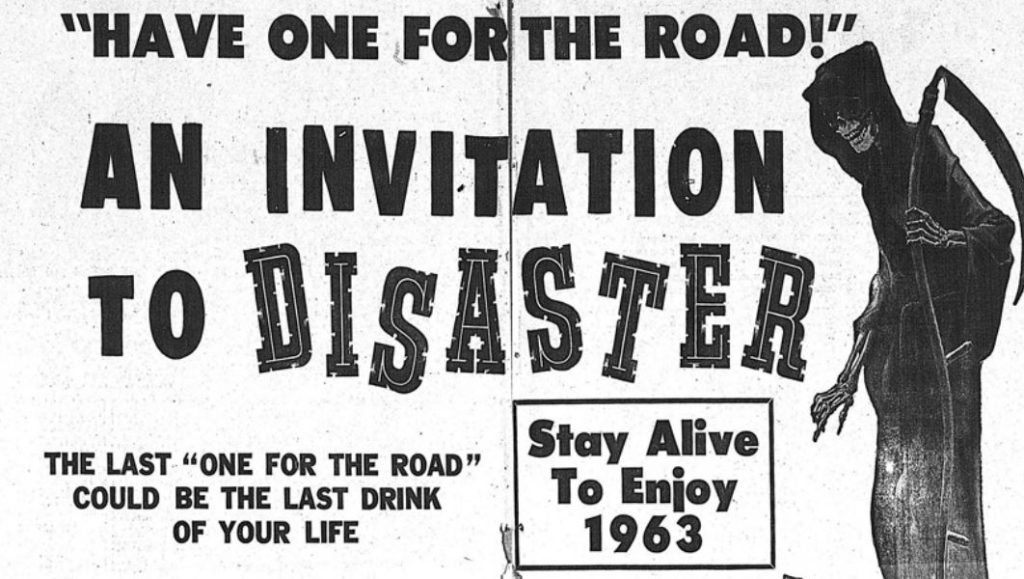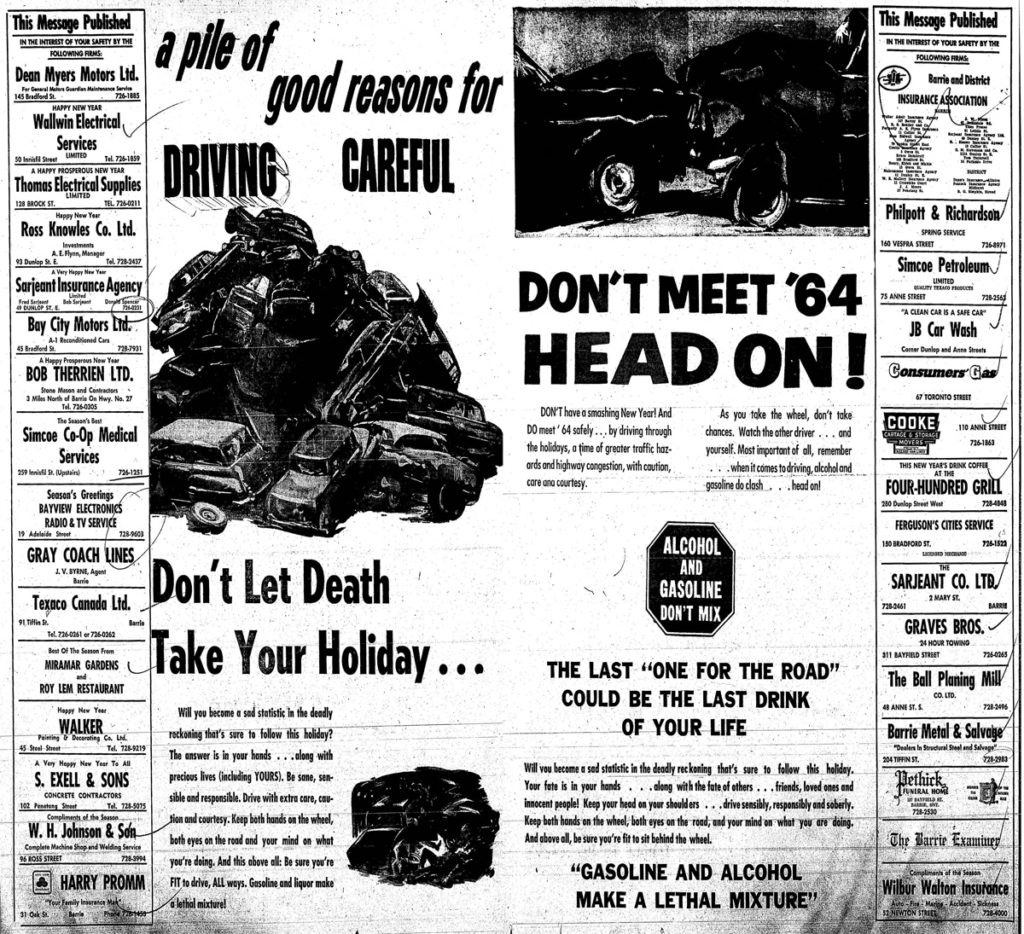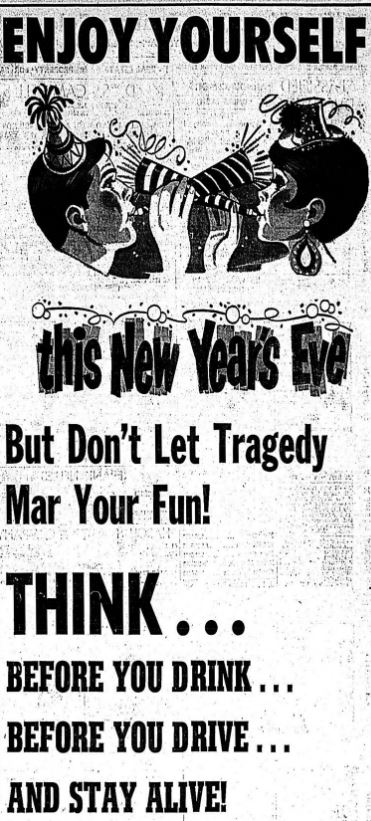In the ‘50s and ’60s, the Barrie Examiner ran a series of New Year’s ads featuring the Grim Reaper, pile-ups, and highway carnage

From the late 1950s until the early 1960s, the Barrie Examiner ran annual ads that warned of the dangers of drunk driving.
As traffic increased during the postwar economic boom, so did concerns about road safety. Christmas and New Year’s Eve were notorious for their high accident rates. By the mid-1950s, public awareness campaigns from all levels of government, the media, and concerned local citizens emphasized better driving techniques and stressed that Ontarians shouldn’t get behind the wheel if they were drunk or tired.
Some of the messages were relatively mild — friendly listicles featuring winter-driving and maintenance tips. Others targeted poor habits: one provincial campaign over New Year’s week in 1957 said to those who cut into traffic, “You’re not a good driver.” There were Christmas ads depicting happy nuclear families that would stay happy if you didn’t drink and drive, and articles that numbed readers with endless holiday accident statistics.
Then there was the Barrie Examiner. Its contributions to improving holiday driving safety during the late 1950s and early 1960s certainly didn’t sugar-coat the potential for tragedy.
Take the paper’s cheerful front page for Christmas Eve, 1959, whose headline screamed “HOLIDAY TOLL STARTS HEAVY.” The first story, “You, Too May Be Killed,” was full of nightmare fuel:
You may die this weekend.
Statistics are not particular how many children may be included, or how many adults, or how full their stockings are or how laden their Christmas tree.
The Canadian highways safety conference predicts one person will be killed every two hours and 20 minutes during the Christmas weekend, a total of 36 traffic deaths during an 84-hour period starting at noon today and ending midnight Sunday. For the province of Ontario, 13 people will be killed.
Of those doomed, none know they are marked for death. Certain well-publicized precautions will reduce the odds of a fatal accident. Among them: Make it a happy Christmas, but not overly merry.
The rest of the page reported the carnage from the rest of the province over the previous two days. Three had been killed in a head-on collision near St. Thomas. Pembroke had seen its first road fatality in more than two years. A father had accidentally run over and killed his three-year-old child near Wiarton. Barrie Police Chief Edward Tschirhart warned that drunk drivers would be shown no leniency that season and urged people to use taxis. “An accident is an accident,” he said, “but this time of year it’s going to hurt worse than any other time.”

A week later, the paper published the first of what would be an annual series of New Year’s ads sponsored by local businesses. It depicts Death reaching out to a car leisurely driving along a curving mountain road. The ad offers useful tips, but also dire warnings: “Remember that death rides beside you if you drive when you’ve been drinking!” and “You can be in the right as to who has the right-of-way at an intersection and prove it by losing your life!”
 The next year, the New Year’s ad was a two-page spread illustrated with accident-scene photos and a reprint of an article outlining how Ontario had led the country in New Year’s weekend road fatalities.
The next year, the New Year’s ad was a two-page spread illustrated with accident-scene photos and a reprint of an article outlining how Ontario had led the country in New Year’s weekend road fatalities.
In 1961, the Grim Reaper made an appearance — complete with scythe — hovering over a wrecked car and some poor soul splayed on the ground. “DEATH TAKES NO HOLIDAY,” the ad proclaimed. But it also suggested the horror show may have been working. It reprinted an Examiner article from Boxing Day in which OPP officials and local police congratulated Barrie drivers for not having caused any serious accidents over Christmas.
The 1962 spread is the most ghoulish of all. A Grim Reaper is joined by another skeletal figure who merrily wraps its bony arm around a smiling fedora-wearing man. “OK pal, the next one’s on me!” suggests the skeleton, who’s standing in front of the same smashed-up car that appeared the year before.
That year ended up being a good one for Barrie’s roads — for the first time since 1956, there were no fatalities all year. Tschirhart felt the credit should go to better-informed drivers, as well as improved signage for motorists and pedestrians, and safety equipment distributed by local service clubs.
From that point on, the Examiner’s ads were considerably less macabre. The Grim Reaper was replaced by a mound of wrecked cars in 1963, and a disembodied floating head wagging a disembodied finger in 1964. The series went out with a whimper on New Year’s Eve 1966 with generic clipart of revellers and a simple reminder to have fun — but to think before driving.
Sources: the January 3, 1957 edition of the Colborne Express; the December 24, 1959, December 31, 1959, December 30, 1960, December 30, 1961, December 31, 1962, January 3, 1963, December 30, 1963, December 31, 1964, and December 31, 1966 editions of the Barrie Examiner; and the November 30, 1957 edition of the Globe and Mail.
Source: TVO
